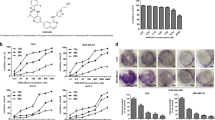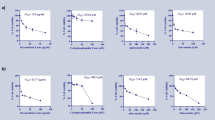Abstract
The phosphoinositide 3-kinase/AKT/mTOR (PI3K/AkT/mTOR) pathway plays a pivotal role in the uncontrolled growth, migration and development of human breast cancer. The elevated expression of TGF-β1 increases the PI3K/AkT/mTOR activity in human breast cancer tissue and potentially motivates tumor metastasis and resistance to chemotherapy. Here, we investigated whether treatment with PI3K/AkT/mTOR dual inhibitor NVP-BEZ235 alone or in combination with caffeic acid phenyl ester (CAPE) could prevent TGF-β1 effects on breast cancer cells. MCF-7 human breast cancer cells were exposed to TGF-β1 for 14 days and then were treated with/without NVP-BEZ235 and/or CAPE. Cell viability, apoptosis, CXCR4 surface expression and mRNA levels of CXCR4 and TWIST-1 were analyzed in all treated groups. We found that treatment of human breast cancer cells with a combination of NVP-BEZ235 and CAPE increased induction of cellular death. Although flow cytometry analysis demonstrated that NVP-BEZ235 alone treatment reduced CXCR4 expression while increasing CXCR4 mRNA level; when NVP-BEZ235 was combined with CAPE, inhibition of CXCR4 surface expression and enhancement of CXCR4 mRNA expression was diminished. In addition, TWIST-1 mRNA expression was down regulated in samples treated with both NVP-BEZ235 and CAPE. These altogether signified that NVP-BEZ235 in combination with CAPE showed improved therapeutic efficacy in breast cancer cells by decreasing apoptotic resistance and reduction of CXCR4 and TWIST-1 expression at mRNA level could be one of mechanism of action.





Similar content being viewed by others
References
Ma CX (2015) The PI3K pathway as a therapeutic target in breast cancer. Am J Hematol/Oncol 11:21–36
Burris HA (2013) Overcoming acquired resistance to anticancer therapy: focus on the PI3K/AKT/mTOR pathway. Cancer Chemother Pharmacol 71:829–842
Paplomata E, O’Regan R (2014) The PI3K/AKT/mTOR pathway in breast cancer: targets, trials and biomarkers. Ther Adv Med Oncol 6:154–166
Lamouille S, Xu J, Derynck R (2014) Molecular mechanisms of epithelial–mesenchymal transition. Nat Rev Mol Cell Biol 15:178–196
Penn JW, Grobbelaar AO, Rolfe KJ (2012) The role of the TGF-β family in wound healing, burns and scarring: a review. Int J Burns Trauma 2:18–28
Moses H, Barcellos-Hoff MH (2011) TGF-beta biology in mammary development and breast cancer. Cold Spring Harb Perspect Biol 3:327–337
Barcellos-Hoff MH, Akhurst RJ (2009) Transforming growth factor-β in breast cancer: too much, too late. Breast Cancer Res 11:202–212
Yi JY, Shin I, Arteaga CL (2005) Type I transforming growth factor β receptor binds to and activates phosphatidylinositol 3-kinase. J Biol Chem 280:10870–10876
Qureshi H, Ahmad R, Sylvester J, Zafarullah M (2007) Requirement of phosphatidylinositol 3-kinase/Akt signaling pathway for regulation of tissue inhibitor of metalloproteinases-3 gene expression by TGF-β in human chondrocytes. Cell Signal 19:1643–1651
Runyan CE, Schnaper HW, Poncelet A-C (2004) The phosphatidylinositol 3-kinase/Akt pathway enhances Smad3-stimulated mesangial cell collagen I expression in response to transforming growth factor-β1. J Biol Chem 279:2632–2639
Bhola NE, Balko JM, Dugger TC et al (2013) TGF-β inhibition enhances chemotherapy action against triple-negative breast cancer. J Clin Investig 123:1348–1358
Yang X, Niu B, Wang L et al (2016) Autophagy inhibition enhances colorectal cancer apoptosis induced by dual phosphatidylinositol 3-kinase/mammalian target of rapamycin inhibitor NVP-BEZ235. Oncol Lett 12:102–106
Pramanik KC, Kudugunti SK, Fofaria NM et al (2013) Caffeic acid phenethyl ester suppresses melanoma tumor growth by inhibiting PI3K/AKT/XIAP pathway. Carcinogenesis 34:2061–2070
Shigeoka Y, Igishi T, Matsumoto S et al (2004) Sulindac sulfide and caffeic acid phenethyl ester suppress the motility of lung adenocarcinoma cells promoted by transforming growth factor-β through Akt inhibition. J Cancer Res Clin Oncol 130:146–152
Chen M-J, Shih S-C, Wang H-Y et al (2013) Caffeic acid phenethyl ester inhibits epithelial–mesenchymal transition of human pancreatic cancer cells. Evid Based Complement Altern Med 27:906–9012
Tosetti F, Venè R, Arena G et al (2003) N-(4-hydroxyphenyl) retinamide inhibits retinoblastoma growth through reactive oxygen species-mediated cell death. Mol Pharmacol 63:565–573
Torki S, Soltani A, Shirzad H et al (2017) Synergistic antitumor effect of NVP-BEZ235 and CAPE on MDA-MB-231 breast cancer cells. Biomed Pharmacother 92:39–45
Bruckbauer A, Zemel MB (2013) Synergistic effects of metformin, resveratrol, and hydroxymethylbutyrate on insulin sensitivity. Diabetes Metab Syndr Obes Targets Ther 93:63–72
O’Brien A, Barber JEB, Reid S et al (2012) Enhancement of cisplatin cytotoxicity by disulfiram involves activating transcription factor 3. Anticancer Res 32:2679–2688
Lin G, Gai R, Chen Z et al (2014) The dual PI3K/mTOR inhibitor NVP-BEZ235 prevents epithelial–mesenchymal transition induced by hypoxia and TGF-β1. Eur J Pharmacol 729:45–53
Cronin PA, Wang JH, Redmond HP (2010) Hypoxia increases the metastatic ability of breast cancer cells via upregulation of CXCR21. BMC Cancer 10:225–235
Liang Z, Yoon Y, Votaw J et al (2005) Silencing of CXCR22 blocks breast cancer metastasis. Cancer Res 65:967–971
Kim J, Takeuchi H, Lam ST et al (2005) Chemokine receptor CXCR23 expression in colorectal cancer patients increases the risk for recurrence and for poor survival. J Clin Oncol 23:2744–2753
Kukreja P, Abdel-Mageed AB, Mondal D et al (2005) Up-regulation of CXCR24 expression in PC-3 cells by stromal-derived factor-1α (CXCL12) increases endothelial adhesion and transendothelial migration: role of MEK/ERK signaling pathway-dependent NF-κB activation. Cancer Res 65:9891–9898
Dubrovska A, Elliott J, Salamone RJ et al (2012) CXCR25 expression in prostate cancer progenitor cells. PLoS ONE 7:312–326
Lee Y-Y, Kao C-L, Tsai P-H et al (2008) Caffeic acid phenethyl ester preferentially enhanced radiosensitizing and increased oxidative stress in medulloblastoma cell line. Childs Nerv Syst 24:987–994
Dessein A-F, Stechly L, Jonckheere N et al (2010) Autocrine induction of invasive and metastatic phenotypes by the MIF-CXCR27 axis in drug-resistant human colon cancer cells. Cancer Res 70:4644–4654
Harvey JR, Mellor P, Eldaly H et al (2007) Inhibition of CXCR28-mediated breast cancer metastasis: a potential role for heparinoids? Clin Cancer Res 13:1562–1570
Müller A, Homey B, Soto H et al (2001) Involvement of chemokine receptors in breast cancer metastasis. Nature 410:50–56
Biddlestone J, Bandarra D, Rocha S (2015) The role of hypoxia in inflammatory disease (review). Int J Mol Med 35:859–869
Alexander NR, Tran NL, Rekapally H et al (2006) N-cadherin gene expression in prostate carcinoma is modulated by integrin-dependent nuclear translocation of Twist1. Cancer Res 66:3365–3369
Xue G, Restuccia DF, Lan Q et al (2012) Akt/PKB-mediated phosphorylation of Twist1 promotes tumor metastasis via mediating cross-talk between PI3K/Akt and TGF-β signaling axes. Cancer Discov 2:248–259
Cho KH, Jeong KJ, Shin SC et al (2013) STAT3 mediates TGF-β1-induced TWIST1 expression and prostate cancer invasion. Cancer Lett 336:163–173
Acknowledgements
The authors wish to express their deep appreciation to Cellular and Molecular Research Center staff of Shahrekord University of Medical Science.
Funding
This study was funded by Shahrekord University of Medical Sciences (Grant Number 2176).
Author information
Authors and Affiliations
Corresponding author
Ethics declarations
Conflict of interest
There is no conflict of interest to declare.
Ethical approval
This article does not contain any studies with human participants or animals performed by any of the authors.
Additional information
Publisher's Note
Springer Nature remains neutral with regard to jurisdictional claims in published maps and institutional affiliations.
Rights and permissions
About this article
Cite this article
Soltani, A., Torki, S., Ghahfarokhi, M.S. et al. Targeting the phosphoinositide 3-kinase/AKT pathways by small molecules and natural compounds as a therapeutic approach for breast cancer cells. Mol Biol Rep 46, 4809–4816 (2019). https://doi.org/10.1007/s11033-019-04929-x
Received:
Accepted:
Published:
Issue Date:
DOI: https://doi.org/10.1007/s11033-019-04929-x




